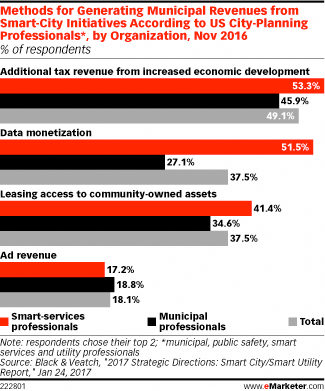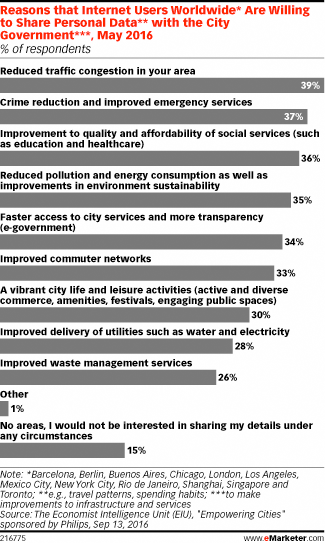What Marketers Need to Know About Smart Cities
June 2, 2017
![]() The smart-city market is in its early stages of development.
The smart-city market is in its early stages of development.
Some of the most common applications include transportation and parking, energy management, water management, lighting, environmental monitoring, public safety and communications, waste management and smart buildings.
But as smart cities become more ubiquitous, so too will opportunities for marketers—including those in the city governments themselves—to get closer to consumers.
“Some are already experimenting with different models and collaborating on projects that generate valuable data, purchasing data from cities, and incorporating public data from city projects into marketing efforts,” said eMarketer analyst Victoria Petrock, the author of a new report on the subject.
Strategically placed out-of-home (OOH) devices—including smart signage, information kiosks, billboards and video monitors, as well as notifications on smartphones and other mobile devices—are platforms for sharing content, orchestrating messaging and forging deeper customer relationships.
 “A smart city with all this connectivity will create more touchpoints with consumers, more opportunities to market, and will put a brand in front of consumers,” said Steve Koenig, senior director of market research at the Consumer Technology Association. “If you know that Joe Citizen tends to walk past a [digital] billboard, an ad could be instantly tailored to him and shown for 30 seconds. But when somebody else walks by, they might see an ad for something completely different.”
“A smart city with all this connectivity will create more touchpoints with consumers, more opportunities to market, and will put a brand in front of consumers,” said Steve Koenig, senior director of market research at the Consumer Technology Association. “If you know that Joe Citizen tends to walk past a [digital] billboard, an ad could be instantly tailored to him and shown for 30 seconds. But when somebody else walks by, they might see an ad for something completely different.”
Methods for Generating Municipal Revenues from Smart-City Initiatives According to US City-Planning Professionals*, by Organization, Nov 2016 (% of respondents)
A Black & Veatch study found that advertising was among the methods that US city-planning professionals were using to monetize their smart-city initiatives.
 Intersection, a company owned by Alphabet’s Sidewalk Labs, is part of a consortium working with New York on the LinkNYC program, which is replacing some of the city’s pay phones with kiosks that provide free, high-speed Wi-Fi, phone charging, information services and display screens that serve up a mix of public service messages and advertising.
Intersection, a company owned by Alphabet’s Sidewalk Labs, is part of a consortium working with New York on the LinkNYC program, which is replacing some of the city’s pay phones with kiosks that provide free, high-speed Wi-Fi, phone charging, information services and display screens that serve up a mix of public service messages and advertising.
Dave Etherington, the company’s chief strategy officer, told eMarketer that incorporating paid media models into smart-city development is key to helping fund new technologies and services. “With these advertising contracts, we’re able to introduce not just increased advertising revenue for cities, but we can bring in new technologies and innovation.”
Reasons that Internet Users Worldwide* Are Willing to Share Personal Data** with the City Government***, May 2016 (% of respondents)
Location-based data from smart-city projects can help cities—and their marketing partners—enhance consumer experiences.
According to a Q1 2017 report by Unacast, many industries were already using proximity technology—some of which is connected to smart-city projects. This included beacons, GPS and geofencing, Wi-Fi services, NFC, audio and light sensors. This data can be combined with online behavioral data to create more complete profiles of consumers. “We know every single click and what you read, what you buy, what you watch online, but the physical space has been very much unknown,” Unacast’s Walle said. “With more physical data, this is changing.”
For example, beacons, payment systems and GPS sensors in transportation hubs and on vehicles can collect data about a passenger’s entire journey—including ticket purchase, itinerary and onboard Wi-Fi activity. With this information, marketers can serve personalized, location-based messages online or via mobile device, at stations, on digital signage and in vehicles themselves.
Augmented reality (AR) apps like Waze, Snapchat and Google Translate can also use location data to connect people with places in useful and interesting ways. A number of cities already have apps that use this data to help travelers find important services and nearby points of interest, including information about a piece of art in a museum, restaurants along a travel route or a nearby hospital.






























